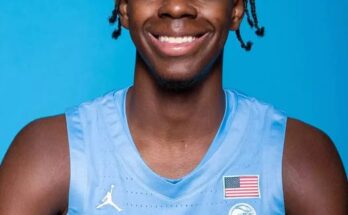Drew Peterson’s recent move from the Boston Celtics to the Charlotte Hornets on a two-way contract marks a significant transition in his professional basketball career, reflecting the dynamic nature of the NBA and the constant adjustments players must make to carve out their place in the league. This shift is emblematic not only of Peterson’s journey as a developing player but also of the strategic decisions teams make when managing their rosters, balancing talent development with immediate competitive needs. To understand the full implications of Peterson’s move, it is important to consider the trajectory of his career up to this point, the nature of two-way contracts, and what this means for both Peterson and the Hornets organization moving forward.
Drew Peterson, a guard known for his tenacity and work ethic, first entered the professional basketball world with aspirations common to many young athletes—aiming to prove himself and earn a permanent spot in the NBA. His journey has been one marked by persistence and gradual growth, having spent time developing his skills in the G League and trying to seize opportunities when called up to the NBA. Peterson’s tenure with the Boston Celtics, a franchise with a rich history and a roster full of talent, provided valuable experience and exposure to high-level competition. However, the depth of talent on the Celtics’ roster often meant limited playing time for players like Peterson, who were on the fringes of the rotation.
The Celtics have long been a team that prioritizes both veteran leadership and the cultivation of young talent. In recent years, they have maintained a competitive squad aiming for deep playoff runs, which sometimes leaves less room for younger, less proven players to get consistent minutes. For Peterson, the Celtics offered a platform to showcase his abilities during limited NBA appearances and extensive G League play, but the crowded backcourt made it difficult for him to secure a steady role. This situation is common for many players caught between the G League and the NBA, as the transition requires not only skill but also timing, opportunity, and sometimes a bit of luck.
The move to the Charlotte Hornets on a two-way contract offers a fresh start for Peterson and potentially a clearer path to more consistent NBA playing time. Two-way contracts, introduced by the NBA in the 2017-2018 season, were designed to give teams the flexibility to develop young players by allowing them to split their time between the NBA and the G League. Players on two-way deals can spend up to 50 games with their NBA team while spending the rest of the season in the G League. This system benefits players like Peterson by providing more structured opportunities for development within the NBA organization, rather than just isolated call-ups.
For the Hornets, signing Peterson to a two-way contract aligns with their current approach of building a youthful and dynamic roster while investing in promising talent. Charlotte has been focusing on developing young players through both their NBA squad and their G League affiliate, aiming to create a pipeline of talent that can contribute immediately or in the near future. The Hornets have shown a willingness to give opportunities to players who demonstrate potential, and Peterson’s skill set fits into that mold. Known for his defensive effort, shooting ability, and competitive spirit, Peterson could provide valuable depth in the guard position while continuing to improve his game in a supportive environment.
The strategic significance of this signing extends beyond Peterson himself. It reflects how NBA teams are increasingly leveraging two-way contracts to maintain roster flexibility and nurture talent without committing full roster spots. For players, it underscores the importance of adaptability and readiness to seize new opportunities wherever they arise. Peterson’s decision to move from a storied franchise like Boston to a rebuilding team like Charlotte highlights the balancing act many players face between staying with prestigious teams and finding places where they can play more and grow.
Examining Peterson’s development so far, his strengths have centered around his shooting and defensive tenacity. In the G League, he has demonstrated an ability to score efficiently, showing a smooth shooting stroke from beyond the arc and decent ball-handling skills to create his own shot. Defensively, Peterson’s effort and energy often stand out, as he consistently looks to apply pressure on opposing guards and contribute to team defensive schemes. These attributes are valuable in the modern NBA, where spacing and perimeter defense are critical components of successful teams. However, like many young players, Peterson has areas to improve, including decision-making under pressure, consistency, and expanding his playmaking capabilities.
The Hornets’ coaching staff and development personnel are likely to focus on refining these skills as Peterson joins their system. With a roster that includes young stars like LaMelo Ball and other emerging talents, Peterson will have the chance to learn and grow in a setting that encourages skill development and offers potential playing time as the team evaluates its depth chart. The Hornets’ commitment to youth and development means Peterson could play a pivotal role if he continues to improve, possibly earning regular minutes in the rotation or even a full NBA contract in the future.
From the perspective of the Celtics, the decision to let Peterson move on may reflect their confidence in other players and their roster needs at the time. Teams constantly assess their personnel to maximize both immediate success and long-term potential, and sometimes that means making tough choices about players on the cusp. The Celtics’ deep guard rotation includes established veterans and promising young players, making it difficult for Peterson to find a consistent spot. Although his departure is a loss of depth, it also opens up opportunities for other players within the Celtics’ system to develop.
The move also speaks to the broader landscape of player movement in the NBA today. With two-way contracts, two-way players, and two-way deal dynamics, the league has created a more fluid environment where players can switch teams more easily in search of better fits and opportunities. Peterson’s transition from the Celtics to the Hornets exemplifies this fluidity, showcasing how players and teams are constantly adjusting their strategies and lineups based on development goals, roster needs, and competitive windows.
For Peterson personally, the move represents a pivotal moment in his career. It is a chance to prove himself in a new environment, gain more playing time, and continue to develop his game at the highest levels. The two-way contract offers him a structured path to demonstrate his value to the Hornets and potentially secure a full NBA contract. Success in this role could open doors not only in Charlotte but across the league, as teams always seek hard-working, skilled players who can contribute on both ends of the floor.
Moreover, Peterson’s journey reflects the realities faced by many talented players on the fringes of the NBA. Not every player enters the league as a top draft pick or immediate star; many must work their way up through perseverance, adapting to new teams, and making the most of limited opportunities. His story is one of resilience and commitment, which resonates with fans who appreciate the grind behind the glamour of professional basketball.
In summary, Drew Peterson’s departure from the Boston Celtics and signing with the Charlotte Hornets on a two-way contract encapsulates the complex interplay between player development, team strategy, and the evolving structure of NBA contracts. This move offers Peterson a promising new opportunity to advance his career in a setting tailored to nurturing young talent, while the Hornets gain a player whose skills and attitude align with their long-term vision. As Peterson embarks on this next chapter, his progress will be closely watched by those who follow emerging talents in the league, illustrating the ongoing narrative of growth, adaptation, and pursuit of NBA success.



